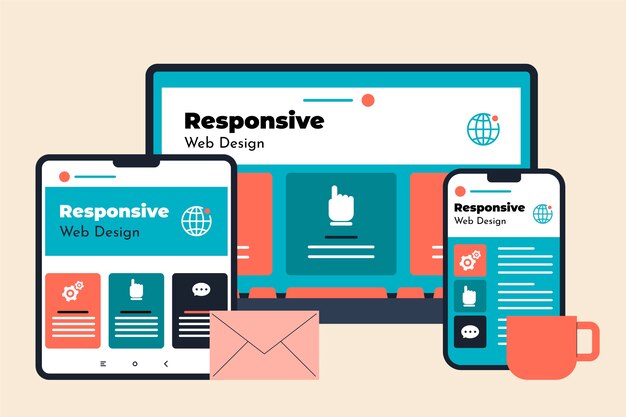In the ever-evolving digital landscape, responsive web design has become an essential aspect of creating a seamless user experience across multiple devices. As we move into 2025, the importance of responsive web design continues to grow, driven by emerging technologies, changing user behavior, and new industry standards. This article explores why responsive web design remains critical in 2025 and how businesses can leverage it for success.
What is Responsive Web Design?
Responsive web design (RWD) is a design approach that ensures websites function optimally on various screen sizes and devices, including desktops, tablets, and smartphones. This is achieved through flexible grids, fluid layouts, and adaptive media elements that adjust based on the user’s device.
Why Responsive Web Design Still Matters in 2025
1. Increasing Mobile Internet Usage
Mobile traffic has consistently outpaced desktop usage in recent years, and this trend shows no signs of slowing down. With the rapid expansion of 5G networks and more powerful smartphones, users expect faster, more seamless browsing experiences. A non-responsive website can result in poor user engagement, high bounce rates, and lost revenue opportunities.
2. Google’s Mobile-First Indexing
Search engine optimization (SEO) is crucial for any website’s visibility. Since Google has prioritized mobile-first indexing, a website’s mobile version determines its search engine ranking. If a website is not mobile-friendly, it risks lower rankings, reducing organic traffic and overall digital presence.
3. Improved User Experience (UX)
A responsive design ensures that users can navigate a website effortlessly, regardless of the device they are using. Clear navigation, readable content, and optimized media elements enhance the user experience, increasing engagement and conversion rates. Businesses that prioritize user-friendly experiences tend to have higher customer satisfaction and retention.
4. Faster Page Loading Speed
Website speed significantly affects user engagement. Studies show that visitors abandon sites that take more than a few seconds to load. Responsive web design often includes optimized images, streamlined code, and efficient caching, which contribute to faster load times and a smoother user experience.
5. Cost-Effectiveness and Easier Maintenance
Maintaining separate desktop and mobile versions of a website is both costly and time-consuming. A responsive web design eliminates the need for multiple versions, simplifying maintenance and reducing long-term costs. Businesses can allocate their resources more efficiently while ensuring a consistent online presence.
6. Enhanced Accessibility and Inclusivity
Accessibility is a growing concern in web development. A well-designed responsive website ensures that people with disabilities, using screen readers or other assistive technologies, can easily navigate and interact with the content. Adhering to Web Content Accessibility Guidelines (WCAG) helps businesses reach a broader audience while fostering inclusivity.
7. Adapting to Emerging Technologies
As technology advances, new devices such as foldable smartphones, smartwatches, and augmented reality interfaces are gaining popularity. Responsive design principles enable websites to adapt to these emerging technologies, future-proofing digital experiences and maintaining relevance in a competitive market.
8. Boosting Conversion Rates
A seamless and responsive website directly impacts conversion rates. Users who have a positive browsing experience are more likely to complete actions such as making a purchase, signing up for a newsletter, or filling out a contact form. A well-optimized website helps businesses maximize their return on investment (ROI).
Best Practices for Responsive Web Design in 2025
1. Use Flexible Grid Layouts
Designing with a flexible grid system allows elements to resize proportionally based on screen size, ensuring a consistent layout across different devices.
2. Optimize Images and Media
Compressing images, using modern formats like WebP, and implementing adaptive image techniques can enhance performance without sacrificing quality.
3. Prioritize Mobile-Friendly Navigation
Simplified menus, touch-friendly buttons, and easy-to-access content improve the usability of mobile websites, keeping users engaged.
4. Implement Scalable Typography
Using relative units like percentages, ems, or rems instead of fixed pixel sizes ensures text remains readable across all screen sizes.
5. Test Across Multiple Devices
Regularly testing websites on various devices and browsers helps identify potential issues and optimize the user experience accordingly.
6. Leverage Progressive Web Apps (PWAs)
PWAs combine the best of web and mobile apps, offering offline functionality, fast loading times, and app-like interactions, making them an excellent addition to a responsive design strategy.
Conclusion
Responsive web design remains an indispensable aspect of modern web development in 2025. With the continuous rise in mobile usage, evolving SEO practices, and emerging technologies, businesses must prioritize responsiveness to stay ahead of the competition. By adopting best practices and ensuring seamless experiences across devices, companies can enhance user engagement, improve search rankings, and drive conversions. As the digital landscape advances, responsiveness is not just an option—it is a necessity for success in the online world.





